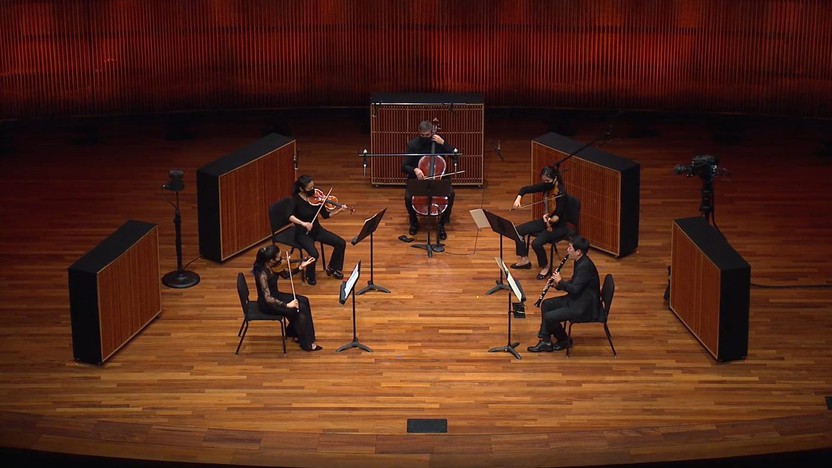Tchaikovsky’s Souvenir de Florence



(Duration: 34 min)
Samuel Coleridge-Taylor received the last part of his name from his father, who had returned home to Sierra Leone (the British colony in Africa originally established as a refuge for people freed and escaped from enslavement) without learning that a white British woman was pregnant with his son. Samuel’s mother gifted her son with an auspicious name modeled after the English poet Samuel Taylor Coleridge, and the boy’s grandfather passed on an even greater gift by introducing Samuel to his own instrument, the violin.
Coleridge-Taylor went on to enroll at London’s Royal Academy of Music at the age of 15 as a violinist, and three years later he began composition lessons as well, even as he was already publishing his earliest compositions. His composition teacher Charles Stanford was a devoted follower of Johannes Brahms, and it was through that influence that the 20-year-old Coleridge-Taylor came to attempt a Clarinet Quintet four years after Brahms wrote his own masterful work in the genre. Stanford was so impressed with the result that he got the score into the hands of the violinist and Brahms ally Joseph Joachim, who ended up performing it with the same clarinetist who had inspired Brahms’ late run of pieces for the instrument.
It was only in later years that Coleridge-Taylor channeled African and African American themes into works that proved hugely influential for future generations of American composers, a project that was still gathering steam when he died of pneumonia at the age of 37. In this Clarinet Quintet and other early works, he laid his musical foundation in the Brahms and Antonín Dvořák tradition of finely-wrought “pure” music in traditional forms. The closest this work comes to the territory of folk music influence is in the plucked chords from the violins that propel the quintet out of the gate, preparing the entrance of the clarinet with the main melody that has a tinge of Dvořák’s Slavic sound.
The Larghetto affettuoso (a slow tempo with an indication that it should played with affection or tenderness) offers a sweet contrast in the key of B-major, offsetting the intensity of F-sharp minor. At the end of finale, a recurring pattern of vigorous rhythms softens and gets superimposed with a recall of the Larghetto theme from the clarinet, a detail that speaks to Coleridge-Taylor’s maturity and sense of cohesion in crafting an arc across the entirety of a major composition.
Aaron Grad ©2023

(Duration: 20 min)
In 1886, when the Saint Petersburg Chamber Music Society awarded Pyotr Ilyich Tchaikovsky an honorary membership, he promised to write a new work for them, but it ended up taking six years and many course corrections before their score was ready. Around the time he made his first sketches in the summer of 1887, he confessed his pernicious self-doubt in a letter, lamenting, “I’m beginning to fear that I am losing my powers of composition, and becoming angry with myself.”
Picking up the score again in 1890, which he had decided to construct as a string sextet in the mold of Johannes Brahms, he wrote to a fellow composer that he found it “terribly difficult working in this new form; it seems that rather than writing for six voices, I am, in essence, composing for the orchestra, and only then arranging it for six string instruments.” He gathered musicians to perform a draft that he appraised as “astonishingly bad in all respects,” and he put it down again until a quiet few weeks in Paris during the winter of 1891–92. Finally happy with the score, Tchaikovsky gave it the fond title Souvenir de Florence, a tribute to the city where, early in 1890, he jotted down the melody that would become the basis of the slow movement.
Souvenir de Florence makes an arresting entrance, launching immediately into a melody that starts with an unstable harmony and a crunchy four-note chord attacked fortissimo by the first violin. This fast and spirited opening movement in the key of D-minor turns out to be more frisky than fierce, maintaining a dance-like lift in its three-beat pulse.
After a tapering introduction, the slow movement presents the Florence-born theme, played dolce cantabile (sweet and singing) by the first violin over effervescent plucking, a texture that approximates the character of an Italian mandolin or guitar accompanying a love serenade. In a letter to his contact at the Chamber Music Society, Tchaikovsky wrote that this movement should be “played with great fire and passion.”
Traces of folksong color the scherzo as well as the lively finale. Tchaikovsky used the full resources of the sextet to craft these themes into more than just memorable tunes, amassing rustic textures and sophisticated layers of counterpoint on the way to a thrilling conclusion. Alongside his symphonic swan song from the next year, the Symphony No. 6, Souvenir de Florence stands as the pinnacle of what Tchaikovsky was able to achieve when he married his abundant gift for melody with a hard-earned mastery of formal structures.
Aaron Grad ©2023
Get driving directions and find nearby parking.
Find dining options close to the venue.
View seating charts to find out where you'll be seating.
Get driving directions and find nearby parking.
Find dining options close to the venue.
View seating charts to find out where you'll be seating.
